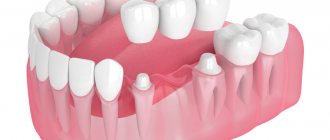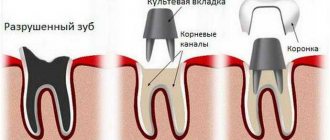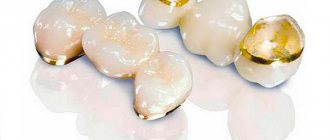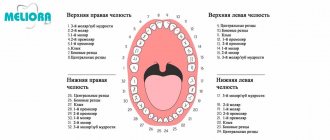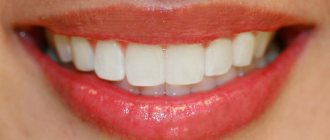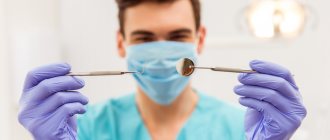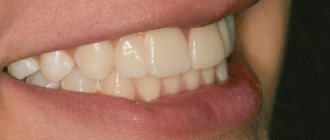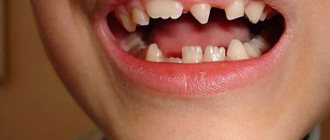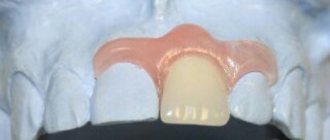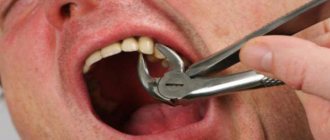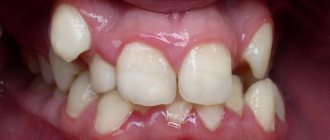Fine, an adult must have 32 dental units: sixteen each on the lower and upper jaws. Their structure differs depending on the location and functional task. According to the same criteria, permanent teeth are divided into four types: molars, intended for chewing and grinding food, canines and incisors, necessary for biting, tearing and holding it, and premolars, performing all of these functions.
Difference between molars and premolars
The main difference between molar teeth and premolars is their location on the jaw.
Premolars are located closer to the front of the dentition, and molars are slightly moved inward. Their quantity also varies.
There are always two premolars on each side of the upper and lower jaws. There can be either two or three molars. Still others are also called “wisdom teeth.” They grow later than others and often appear only at 20-25 years of age. This process is often accompanied by malaise and fever. However, not all people on earth have third ones. A certain genetic predisposition can cause the absence of wisdom teeth in the oral cavity.
How they cut through
The appearance of premolars does not cause any violent symptoms. Most often, this process occurs without any peculiarities, which cannot be said about molars. They usually appear at the age of 2-3 years, that is, the very last of all dairy products.
The process can cause a deterioration in the baby's appetite. Sometimes he happily accepts soft food or purees, but becomes capricious if he needs to chew something. This is normal, since inflammation often occurs on the gums of chewing teeth before at least one edge of the chewing surface has erupted. Another common symptom is itching and even poor sleep. The child may become more capricious, whiny, and excitable.
The most dangerous symptom for parents seems to be an increase in temperature, but they must remember that if it does not exceed one degree, it can be considered a natural reaction of the body to inflammation of the gums. If the temperature rises above 37.5°C, then the reason is most likely something else, and there is no need to attribute it to teething.
All these symptoms may not be present simultaneously, but in any combination. For some lucky people, teething does not cause any discomfort. Pediatricians largely attribute the reaction to the child’s temperament.
Features of the structure of molars
Molars have a characteristic structure. On the upper jaw they have three roots and four canals. The lower jaw has two roots and three canals. Moreover, the number of canals also differs depending on the location of the individual tooth. Thus, the first of them often have one more channel than the next two.
The main characteristic feature of this type of teeth is the area of their chewing surface. They bear the heaviest load when chewing food particles. The molars themselves also have differences among themselves, which are associated with the structure of the jaw.
Molar Differences
Often the surface of each molar tooth is shaped like a triangle. There is a certain number of tubercles on it, which take an active part in chewing food. The number of such tubercles may vary. Usually there are three, but sometimes there are more.
Such mounds are connected to each other by special ridges. On the upper and lower jaws the structure of these elements is different. In the upper dentition, the apex of the surface triangle is directed towards the tongue. This form is called a trigon. On the lower jaw, the apex of such a triangle is directed towards the cheek, which is called the trigonid. The size of the first and second types of teeth is practically the same.
Helping your child change teeth
Changing baby teeth for molars is safe, but there are certain tips for parents. They need to be taken into account in order to eliminate even minor troubles. Children are not aware of what is happening, so they need some help.
- When a tooth falls out, you need to wait until the last moment and just pick it up.
- After falling out, a small wound remains on the gum where dirt can get in, so it is better to teach your child to rinse the mouth.
- If the wound is bleeding, you can use a soda solution and postpone eating for 2-3 hours.
A visit to the dental clinic is usually not required. In rare cases, swelling or inflammation may develop and require examination by a specialist. If parents take the process seriously, there will be no dangerous consequences, so the child will not have to deal with the unpleasant procedure again.
Possible damage to small molars
Carious lesions of primary and molar teeth in children are observed quite often. This is due to the bumpiness of their surface, which can trap food particles and bacteria. Since children at an early age do not always actively and correctly brush their teeth, these residues can lead to damage to the enamel and deeper spread of caries.
Depending on the degree of damage, caries can penetrate either exclusively into the enamel, or into dentin or even cement. In the latter case, we are talking about deep caries, which often requires serious treatment or even tooth extraction.
Another variant of damage is a change in tissue structure, which may be associated with metabolic disorders in the human body or other diseases. Such a disease can also be the result of poor nutrition or constant diets, in which the body does not receive enough nutrients.
At any age, a person can experience excessive tooth wear, which leads to the destruction of enamel and can cause other serious damage. Teeth can wear down in different situations, such as:
- if a person has bad habits of grinding his teeth, etc.;
- in case of improper or insufficient nutrition;
- in the presence of diseases of the endocrine system;
- due to a genetic predisposition to enamel depletion.
All of these lesions can be the result of both an incorrect lifestyle and various diseases or heredity. Regardless of the reasons, it is necessary to begin treatment of emerging injuries immediately so as not to aggravate the process.
Why are they often affected by caries?
In the anatomical structure of premolars and molars there are fissures - deep grooves between the chewing tubercles. It is in these places that the enamel is very thin. Fissures reach the enamel-dentin border, so such places are closest to the dental nerve.
This is good and bad at the same time. Good because the human tooth is very sensitive due to this feature. Sensitivity is needed in order not to eat too cold or hot, not to overload with stress and too hard food. The practice of sealing fissures does not always pay off, as it greatly reduces sensitivity.
The bad thing is that in this place the surface is closest to the dentin, so any food debris and bacteria developing on them very quickly penetrate into the dental structure. In order to prevent this, normal hygiene is needed: getting used to brushing your teeth, preventative examinations at the dentist, timely treatment at the dentist. Only in this case will molars and premolars perform their function for a long time.
Replacement of primary molars with permanent permanent molars
Molars are the first permanent teeth to appear in a child's mouth. This begins around the age of five. Growth begins with the first molar tooth, which appears in a free space in the depths of the jaw, closer to the milk one that has not yet fallen out.
The second molar usually grows in at the age of 12-13 years. It also takes up free space and does not replace a baby tooth. The latter, or “wisdom teeth,” may take up to 25 years to grow or may not appear at all.
As for dairy products, they begin to fall out from the age of 9. In their place, permanent teeth grow, which occurs at approximately 10-12 years of age. Usually these are the last molars, the growth of which must wait to fill the adult dentition (not counting “wisdom teeth”).
Is it possible to loosen baby molars?
The process of tooth loss always begins with softening of its root. This occurs as the jaw grows, freeing up more space for a permanent tooth. Thus, while the baby tooth is still in the hole, the molar is already beginning to take its correct place.
In this regard, dentists categorically do not recommend deliberately loosening baby molars. If they fall out prematurely, jaw growth may be stunted. As a result, there will not be enough space for permanent teeth, and they will begin to grow crookedly, getting out of the general dentition.
Signs of imminent appearance of molars
The first signs that molars are about to appear are noticeable even before the baby teeth fall out. These include the following:
- widening of the jaw, which can be seen when gaps appear between other baby teeth;
- the appearance of sufficient free space behind the outer lateral milk teeth;
- swelling of the gums.
In this case, the temperature does not necessarily have to rise or the child’s well-being deteriorates, as was the case with the growth of baby teeth. This is why the appearance of the first molars often goes unnoticed.
Helping your child replace teeth
The process of replacing teeth often takes place without pain or discomfort. The roots of baby teeth dissolve on their own, and the dental crown falls out freely. However, there are a number of recommendations that should be followed during this period.
The main one is systematic rinsing of teeth for disinfection purposes. This is necessary in order to avoid bacteria from entering the hole that will form at the site of the falling tooth. In addition, the sharp edges of a crown that has separated from the gum may cause minor damage to soft tissue. To prevent them from becoming inflamed, it is important to exclude any infection.
If your child experiences any pain during the tooth replacement stage, you should immediately consult a doctor. Under no circumstances should pain be eliminated using improvised methods.
Molars and prevention of their loss
Molars are stronger than baby teeth. However, they need proper care to prevent their loss, because new ones will not grow in place of a lost tooth.
Prevention of molar tooth loss involves proper oral hygiene. It includes systematic brushing of teeth, use of dental floss and mouthwash. In addition, you should carefully monitor the condition of your teeth and consult a doctor if even minor damage is detected.
Proper balanced nutrition is also mandatory. Especially in childhood and adolescence, you need to ensure that your body gets enough calcium and vitamin D.
Will loosening help speed up growth?
When forming the jaw, some parents try to speed up the process. When they notice loosening, they support it, hoping that a new molar will appear immediately after it falls out. Dentists try to predict such a mistake, arguing that it is impossible to do this. The consequences of such actions become the most problematic. What are the doctors talking about?
- Incorrect positioning of molars;
- Malocclusion;
- Improper jaw growth.
Wrong actions lead to dire consequences. The natural process cannot be disrupted in any way, so it is better to wait until the tooth gradually loosens on its own and falls out. In this case, there will be no negative effects, and the condition of the jaw will remain ideal.
Parents need to come to dental clinics regularly. Crooked teeth most often appear during the process of changing baby teeth to molars, after which it is necessary to install braces. They will help correct the bite, but for the child the procedure usually entails stress. So there is no need to allow unpleasant consequences.
Maxillary premolars
The crown of the premolars on the upper dentition has a prismatic shape. The buccal and palatal bones often have a convex surface. The first and second premolars in the row also have their differences.
First premolar
The difference between the first premolar of the upper jaw is the predominance of the vestibular surface over the palatal surface. Its contact surfaces are rectangular in shape. The buccal tubercle has two distinct slopes. The root of such a tooth often has a bifurcation.
Second premolar
In such a tooth, the buccal surface usually predominates over the palatal surface, which is more rounded. In most cases, this premolar tooth has a single cone-shaped root. However, there are also cases when it has a split.
